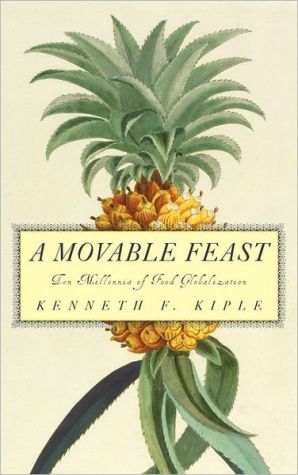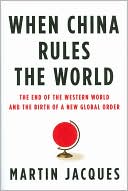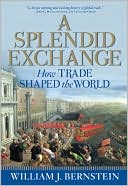Movable Feast
In the last twenty-five years alone, the range of fruits and vegetables, even grains, that is available at most local markets has changed dramatically. Over the last 10,000 years, that change is almost unimaginable. This groundbreaking new work, from the editor of the highly regarded Cambridge World History of Food, examines the exploding global palate. It begins with the transition from foraging to farming that got underway some 10,000 years ago in the Fertile Crescent, then examines...
Search in google:
This book provides a look at the globalization of food from the days of the hunter-gatherers to present-day genetically modified plants and animals. Publishers Weekly Recycling much historical material from the magisterial Cambridge World History of Food(which the author co-edited), this slender volume distills 10,000 years of food history into just 300 pages. While the first work was notable for its rich multiplicity of voices and deeply informed scholarship, this one is a bit of a hash, owing to its author's insistence on squeezing a far-ranging narrative into the narrow framework of globalism. Far from being a new economic concept, the globalization of food, asserts Kiple, is as old as agriculture itself (globalization being murkily defined as "a process of homogenization whereby the cuisines of the world have been increasingly untied from regional food production, and one that promises to make the foods of the world available to everyone in the world"). The strongest material examines the spread of agriculture and its ramifications: it's a paradox of civilization that increased food production encourages population growth, which invariably creates food shortages and disease. That said, gastronomes will find scraps to nibble on here and there—who knew, for example, that the Egyptians trained their monkeys to harvest grapes? (June)Copyright 2007 Reed Business Information
Preface: A movable feast: ten millennia of food globalization; Introduction: from foraging to farming; 1. Last hunters, first farmers; 2. Building the barnyard; 3. Promiscuous plants of the northern fertile crescent; 4. Peripatetic plants of Eastern Asia; 5. Fecund fringes of the northern fertile crescent; 6. Consequences of the Neolithic; 7. Enterprise and empires; 8. Faith and foodstuffs; 9. Empires in the rubble of Rome; 10. Medieval progress and poverty; 11. Spain's New World, the Northern Hemisphere; 12. New world, new foods; 13. New foods in the Southern New World; 14. The Columbian exchange and the Old Worlds; 15. The Columbian exchange and the New Worlds; 16. Sugar and new beverages; 17. Kitchen Hispanization; 18. Producing plenty in paradise; 19. The frontiers of foreign foods; 20. Capitalism, colonialism, and cuisine; 21. Homemade food homogeneity; 22. Notions of nutrients and nutriments; 23. The perils of plenty; 24. The globalization of plenty; 25. Fast food, a hymn to cellulite; 26. Parlous plenty into the twenty-first century; 27. People and plenty in the twenty-first century.
\ From the Publisher"Is this, then, a volume, you should rush out and buy? If you chief interest is in the nutritional effects of changing diets...you might well find it worthwhile." \ -Gastronomica\ "I was pleased to find three commendable qualities in this well-produced and reasonably priced volume: it is packed with fascinating information; it is an admirable exposition on the human propensity to elaborate and find meaning in the most mundane daily tasks and material items; and it would be a useful supplementary text for a course in historical or colonial archaeology."\ -Jonathan Driver, Simon Fraser University, Canadian Journal of Archaeology\ "...Kiple must be congratulated for an informative and unusually entertaining synthesis of ten millennia of history. His expertise in the study of health and disease is apparent, and he is particularly strong when examining the relationship between food preparation, consumption patterns, and well-being."\ -Canadian Journal of History\ "...a book to savor, and to dip back into again and again to nibble at the storehouse of information within." -Kristen M. Burkholder, H-Atlantic\ \ \ \ \ \ Publishers WeeklyRecycling much historical material from the magisterial Cambridge World History of Food(which the author co-edited), this slender volume distills 10,000 years of food history into just 300 pages. While the first work was notable for its rich multiplicity of voices and deeply informed scholarship, this one is a bit of a hash, owing to its author's insistence on squeezing a far-ranging narrative into the narrow framework of globalism. Far from being a new economic concept, the globalization of food, asserts Kiple, is as old as agriculture itself (globalization being murkily defined as "a process of homogenization whereby the cuisines of the world have been increasingly untied from regional food production, and one that promises to make the foods of the world available to everyone in the world"). The strongest material examines the spread of agriculture and its ramifications: it's a paradox of civilization that increased food production encourages population growth, which invariably creates food shortages and disease. That said, gastronomes will find scraps to nibble on here and there—who knew, for example, that the Egyptians trained their monkeys to harvest grapes? (June)\ Copyright 2007 Reed Business Information\ \








